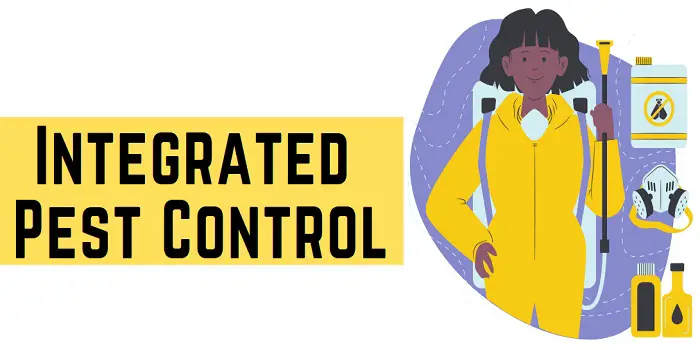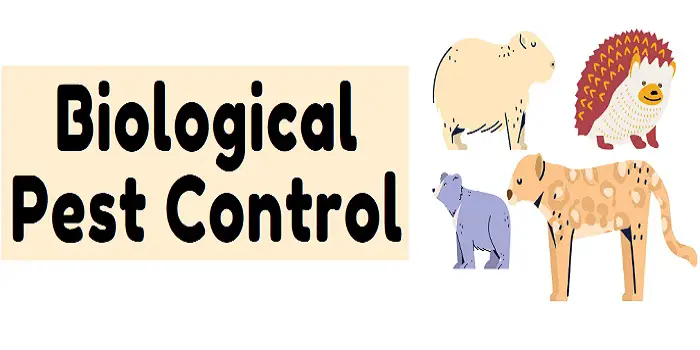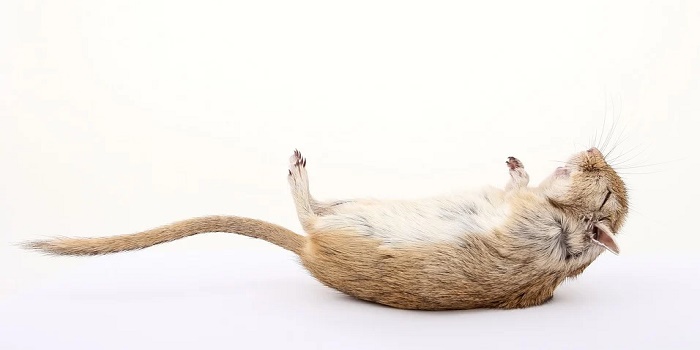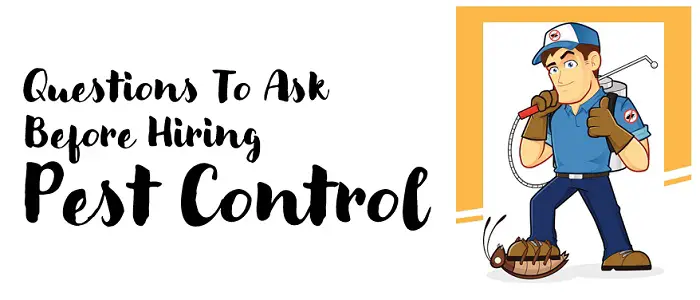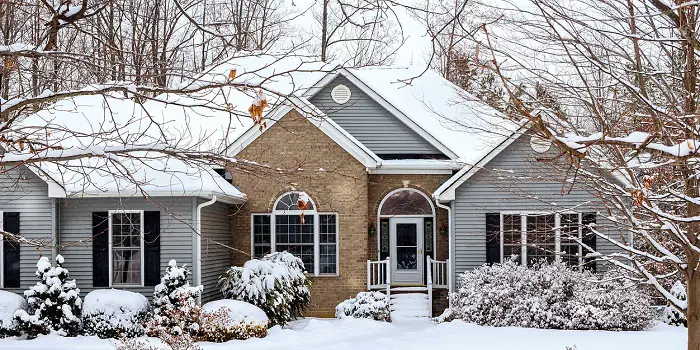
Many times people ask me whether they can do pest control in the winter.
Also, if it is really important, or can they postpone it?
Well, your home can be quite a comfortable place in the wintertime.
With the heat from the fireplace, furnace, or heating unit keeping the cold out, it is your shelter from the cold and wind of the winter.
Unfortunately, it is also a place that may attract plenty of unwanted guests as well.
Not your family or neighbors, but insects, arachnids, and animals that look for shelter during these cold times.
And that’s the reason why you should be planning for a post-control session just before the cold season begins.
Why are Pests Attracted to Your Home in Winter?
The warm temperatures inside your home are mostly the reason why so many pests will find their way inside in winter.
Some will do so to seek out food, while others will find refuge from not only the cold but also predators looking for them.
But many pests would never find their way inside if you didn’t leave openings for them to enter.
Some of the more common entryways into your home include the following.
- Gaps Under Doors
- Dryer Vents
- Cracks in the Foundation
These are the most common means of entry. But any place that pests can reach may provide an entrance to your home.
Including any plants, bushes, or tree branches that come into contact with your house.
In addition, the presence of food inside the home also attracts pests. Trash cans without secure lids are another issue you should address as well.
But even so, it pays to know what type of pest will most likely make its way into your home.
7 Pests that can Invade Your Home During the Winters
Seven of the many pests that may find their way into your home are the most problematic.
1- House Mice:
The most common rodents found in the home, mice, like to nest in safe, secure areas such as the ceiling, attic, or basement where it is dark.
This is because mice have many predators, so the safer the location, the more likely they are to nest and create more rodents.
Although rather innocuous, the typical mouse offers several issues threatening the health and well-being of those inside your home.
- Salmonella
- Tapeworms
- Property Damage
- Fires
- Food Contamination & More
Mice also carry diseases, which can be problematic if you or someone in your home comes into contact with them.
However, there are ways you can minimize the intrusions of mice during the winter months.
Inspect:
The first step is to inspect your home for any signs of mice.
While you may never see one, they do leave behind droppings, gnaw marks, and bites from food that they have consumed.
Remove Clutter:
Piles of boxes, trash, and other clutter must be removed from the home. Otherwise, you provide mice with a home that they can breed.
Seal All Entrances:
Mice need little room to enter a home; sometimes, a hole as small as a dime is enough.
Seal all holes and cracks outside the home using caulk or steel wool which is weather-resistant. Once sealed, they will have considerable difficulty entering your home.
You will need to conduct regular inspections to ensure that house mice are not present in your home.
Plus, keep mouse traps, poisons, and other deterrents handy to catch the mice, just in case.
2- Norway Rats:
Larger than mice, Norway rats can be quite problematic. Just like mice, they like nesting and breeding in debris and clutter.
Plus, they can gnaw through wood and plastic easier than mice which makes them harder to keep out.
It does not help that they carry diseases such as cowpox virus, jaundice, and rat-bite fever, to name a few.
- Inspect: Regularly inspect your home for signs of any Norway rat infestation.
- Remove Moisture: This means eliminating moist areas in the basement and crawl spaces.
- Seal Openings: Since Norway rats are larger than mice, they can fit through holes about ½” in diameter. If you seal the openings for mice, it will also deter Norway rats.
3- German Cockroaches:
You may know them simply as cockroaches, as German cockroaches are far away from the most common type.
For the most part, cockroaches are known to invade homes mostly for food.
And they have adapted over the years to gear themselves to find homes in which they can live and reproduce.
You mostly see cockroaches in kitchens, bathrooms, and other sources of moisture.
They present a real danger to the home in the form of spreading diseases and bacteria along with contaminating sources of food.
One lesser-known issue is that they can make respiratory illnesses such as asthma even worse, especially in children.
- Inspect: Check the kitchens and bathrooms, and where you keep the garbage should be priorities.
- Clean: Clean all counters and floors. Keep food off of them.
- Vacuum: Sweep up all the dirt and debris
- Garbage: Toss out all garbage regularly, as cockroaches love to live in cans and bags
Cockroaches are a threat year-round, so inspect often.
4- Brown Recluse Spiders:
While most spiders are harmless, a few, like the black widow, for example, carry dangerous poison.
However, the brown recluse spider provokes the most fear because of its painful bite and the long-lasting damage it can cause.
Most spiders prefer to hide inside boxes, shoes, clothing, and window moldings.
If they bite you, the venom will start to eat away at the skin, which is quite painful, leaving behind a long-lasting scar.
- Trim: Cut back branches from the house, as this is the most common way that they enter
- Plastic Containers: Remove open boxes and use plastic containers with lids to store items
- Inspect Items: Seldom-used items such as old shoes, gloves, and even baseball mitts are common places for the brown recluse to live.
If you are bitten, seek medical attention immediately. The sooner you get treated, the more the damage will be limited.
5- Raccoons:
Raccoons are mostly found in the woods, and they love to eat.
Particularly garbage left out around your home.
During the winter, they can make their way into chimneys or openings to find a home inside your home.
Raccoons can make quite a mess, but they can also carry rabies which makes them quite dangerous if you are a bit.
- Inspect: Look for any access points on the roof or high in your home that allow them to enter your attic.
- Seal Trashcans: Be sure to seal up all garbage around your home.
- Mesh Caps: Mesh over chimneys and entranceways that cannot be sealed, such as vents, offer protection against raccoons.
Keep in mind that raccoons are wily and determined, so frequently inspect them to keep them away from your home.
6- Bed Bugs:
Unlike all the other pests on this list, there is only one way for bed bugs to make their way into your home, on a person, or in their belongings.
Bed bugs are parasites that only live on blood, so they are relatively easy to prevent if you do the following.
- Inspect All bags and belongings after making a trip and also when someone else visits your home with their belongings.
- Bedrooms: Bed bugs visit you in bed each night, but they spend their time away from beds near bedposts, under-end tables, and the like. Inspect the area for red droppings.
If you suspect bed bugs, you will need to use special treatments to remove them. Standard poisons and pesticides tend not to work.
7- Termites:
Termites will visit you no matter the time of the year. This means you need to conduct regular inspections.
Because termites can enter through small holes in the foundation, they may go undetected for so long that they may cause thousands of dollars in damage.
If your home uses wood for structural support, have a professional pest control expert do the inspections annually.
How to Keep Your Home Pest-Proof During the Winter Season?
Now that you know what might enter, the next step is keeping them out.
Remember that the spring, summer, and early fall months have plenty of flying insects to keep you busy.
While in the winter, the threat comes mostly from the ground.
While specific advice has been given for each of the seven most common pests to enter the home during the winter, here is some general advice that will help against all pests.
- Inspect: Look for any openings in the home, no matter the size
- Seal Cracks and Holes: No matter the size of the opening, have it sealed
- Remove Clutter: From both inside and outside the home. Keep firewood at least 20 feet away
- Plastic Containers: Get rid of cardboard boxes. Use plastic containers with lids to seal them
- Cover Vents w/Mesh: Chimneys, dryer vents, and the like should have strong mesh coverings
- Door Sweeps: To cover openings below the door.
A little prevention can go a long way, so be sure to inspect regularly for any sign of pest intrusion.
How Can Pest Control Professionals Help in the Cold Winter Months?
As seen above, different kinds of pests, insects, and animals can damage your property, even in winter.
However, with the five steps given below, the professionals can protect your storage and ensure that it is free from pest infection.
Step 1- Evaluation:
Evaluation of the building is challenging, but it is the first step toward a successful pest control program.
Special focus is given to the entrance points, food, and water sources, shelter places, etc.
Suppose it’s your office building like a warehouse. In that case, the professionals also evaluate the areas like the pantry, janitor room, closet, cafeteria, utility room, shipping, and packing area, along with employee and consumer points.
Step 2- Assess building design:
Once the complete evaluation and identification of present and possible problematic locations have been made, the next step is to determine the aggregate number of customers and employees going in and out of the facility daily.
Inspect the areas such as external perimeters of dumpster areas, storage buildings and fence lines and water sources, pedestrian and overhead doors, and electronic conduits.
Step 3- Pest identification:
Every pest has a different treatment procedure according to their reaction to every treatment.
Pest management experts usually collect information from employees to get detailed data about the pests to prevent any future infestations and observe current issues.
Step 4- Tailored programs:
All buildings are different in their way. Thus, every one of us needs a unique pest control program.
Some aspects to keep in mind are the age of the building, the area where it is situated, the weather, the size of the facility, etc.
In order to draft the best pest management program which fits the requirements of the business or homeowner well, professionals will monitor and break down the program according to specific requirements.
Step 5- Sanitation and pest removal:
The goal of every pest control program and maintenance is sanitation.
The success of a pest control procedure and maintenance of a pest-free building depends on the sanitation you keep.
Pest controllers have their service record logs, sighting logs, and sanitation details for the procedure to work effectively. It will prevent health risks and fiscal and legal issues linked with a pest invasion.
The Conclusion
Now you are well aware of the importance of treating your house or business facilities in winter.
If you find the pest control process way too challenging, you always have the option to hire from the list of professional pest control companies who can deal with the problems professionally.
So, why not get in touch with them now and make your property free from pests all year round?
Share the post "Why Is Pest Control Essential Even in Winters?"

Welcome to ProShieldPest.com. I am Tina Jones. I have been working as a pest removal professional in Winslow, Arizona lately. At present, I love to spend my time with my family as a retiree.
Here I share all my knowledge and experiences to help people understand better how they can stop pests at their homes without actually killing them. Hopefully, the information you will find here will help in safeguarding your home! You can check more about me here.

